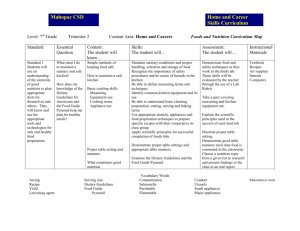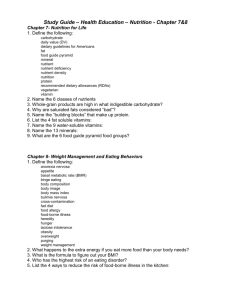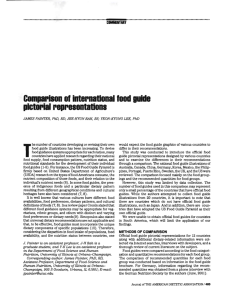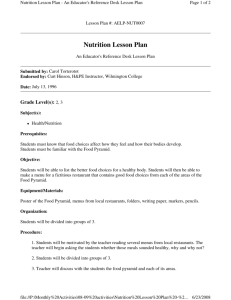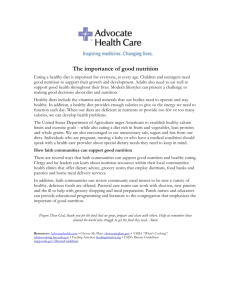Comparison of international food guide pictorial representations
advertisement
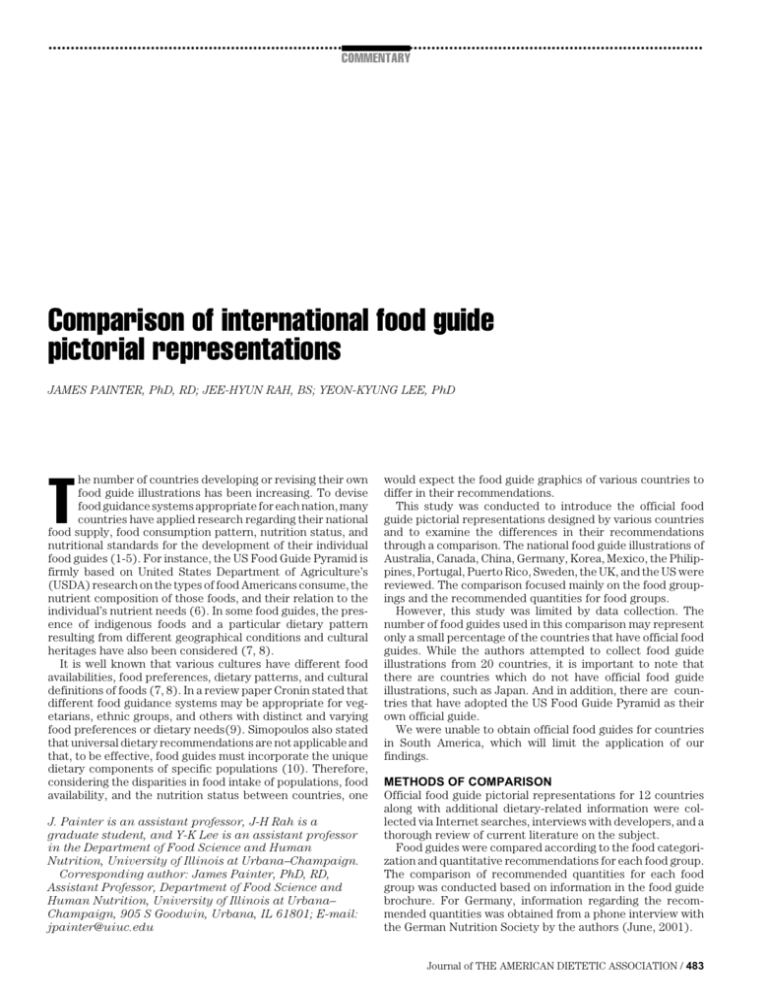
................................................................................................................................................... COMMENTARY Comparison of international food guide pictorial representations JAMES PAINTER, PhD, RD; JEE-HYUN RAH, BS; YEON-KYUNG LEE, PhD he number of countries developing or revising their own food guide illustrations has been increasing. To devise food guidance systems appropriate for each nation, many countries have applied research regarding their national food supply, food consumption pattern, nutrition status, and nutritional standards for the development of their individual food guides (1-5). For instance, the US Food Guide Pyramid is firmly based on United States Department of Agriculture’s (USDA) research on the types of food Americans consume, the nutrient composition of those foods, and their relation to the individual’s nutrient needs (6). In some food guides, the presence of indigenous foods and a particular dietary pattern resulting from different geographical conditions and cultural heritages have also been considered (7, 8). It is well known that various cultures have different food availabilities, food preferences, dietary patterns, and cultural definitions of foods (7, 8). In a review paper Cronin stated that different food guidance systems may be appropriate for vegetarians, ethnic groups, and others with distinct and varying food preferences or dietary needs(9). Simopoulos also stated that universal dietary recommendations are not applicable and that, to be effective, food guides must incorporate the unique dietary components of specific populations (10). Therefore, considering the disparities in food intake of populations, food availability, and the nutrition status between countries, one T J. Painter is an assistant professor, J-H Rah is a graduate student, and Y-K Lee is an assistant professor in the Department of Food Science and Human Nutrition, University of Illinois at Urbana–Champaign. Corresponding author: James Painter, PhD, RD, Assistant Professor, Department of Food Science and Human Nutrition, University of Illinois at Urbana– Champaign, 905 S Goodwin, Urbana, IL 61801; E-mail: jpainter@uiuc.edu would expect the food guide graphics of various countries to differ in their recommendations. This study was conducted to introduce the official food guide pictorial representations designed by various countries and to examine the differences in their recommendations through a comparison. The national food guide illustrations of Australia, Canada, China, Germany, Korea, Mexico, the Philippines, Portugal, Puerto Rico, Sweden, the UK, and the US were reviewed. The comparison focused mainly on the food groupings and the recommended quantities for food groups. However, this study was limited by data collection. The number of food guides used in this comparison may represent only a small percentage of the countries that have official food guides. While the authors attempted to collect food guide illustrations from 20 countries, it is important to note that there are countries which do not have official food guide illustrations, such as Japan. And in addition, there are countries that have adopted the US Food Guide Pyramid as their own official guide. We were unable to obtain official food guides for countries in South America, which will limit the application of our findings. METHODS OF COMPARISON Official food guide pictorial representations for 12 countries along with additional dietary-related information were collected via Internet searches, interviews with developers, and a thorough review of current literature on the subject. Food guides were compared according to the food categorization and quantitative recommendations for each food group. The comparison of recommended quantities for each food group was conducted based on information in the food guide brochure. For Germany, information regarding the recommended quantities was obtained from a phone interview with the German Nutrition Society by the authors (June, 2001). Journal of THE AMERICAN DIETETIC ASSOCIATION / 483 ................................................................................................................................................... COMMENTARY Great Britain Australia Canada China FIG 1. Varieties of shapes and sizes of various nations’ food guide pyramids. 484 / April 2002 Volume 102 Number 4 ................................................................................................................................................... COMMENTARY Philippines Korea Germany Mexico FIG 1 (continued). Varieties of shapes and sizes of various nations’ food guide pyramids. Journal of THE AMERICAN DIETETIC ASSOCIATION / 485 ................................................................................................................................................... COMMENTARY Puerto Rico Portugal United States Sweden FIG 1 (continued). Varieties of shapes and sizes of various nations’ food guide pyramids. 486 / April 2002 Volume 102 Number 4 ................................................................................................................................................... COMMENTARY SHAPES OF FOOD GUIDE ILLUSTRATIONS; PYRAMID, CIRCLE, PAGODA, RAINBOW, AND PLATE Before comparing the actual recommendations, the diverse shapes of these international food guide illustrations should be examined. Previous research indicates that the food guide figure should be effective in conveying the message of moderation and proportionality (11, 12). The USDA conducted an extensive research and consumer survey to decide the design of a national food guide illustration for this country. A wheel, bowl, pie chart, and shopping cart were considered; however, the pyramid was the form that proved to be the easiest to understand (12). While the Philippines adopted the pyramid as a frame for their national food guide, Korea and China chose a pagoda shape. Most of the European countries, on the other hand, have selected a circular form (10). Other unique food guide forms include the rainbow shape of Canada’s ‘Food Guide for Healthy Eating’ and the plate form of ‘The Balance of Good Health’ from the UK and ‘The Dish of Well Eating’ of Mexico. (Figure 1 demonstrates the variety of shapes.) FOOD GROUPING Despite the wide spectrum of shapes representing food guides from around the globe, these guides use very similar methods in presenting their concepts of the ideal dietary pattern. Each of these guides gives consumers a selection of recommended food choices (food groups) as well as a recommended daily amounts consumers should ingest to maintain optimum health. Figure 1 shows a remarkable similarity in the basic food groupings of international food guide illustrations. The groups include: grains, vegetables, fruits, meat, milk and dairy products, and fats and sugar. Despite the differences in indigenous foods of each culture, along with the differences in the cultural definitions of food and what constitutes a usual dietary pattern, the fundamental classification of foods was similar in all countries. Minor differences in food categorization were observed in the fat and sugar group, the vegetable and fruit group, and the milk and dairy product group. The existence of additional groups along with the categorization of foods such as beans, nuts, and potatoes also contributed to these differences. While most of the countries group fat and sugar as a single category, food guides for China, Sweden, Germany and Portugal do not include sugar in the group. The Chinese Nutrition Society has stated that there is no recommendation related to sugar intake in their pagoda because the current consumption of sugar by the Chinese is rather low (13). Moreover, in some food guides, such as the Mexican food guide, the fat and sugar group is not included at all. In an electronic correspondence with the authors (April, 2001), Hector Bourges, MD, PhD, the director of Nutrition in National Institute of Medical Science and Nutrition offered an explanation for this omission. “It is not included in the food guide since we do not try to say that it is part of the diet and since it is an ingredient rather than food”. The fat and sugar group in the food guides for Canada and Australia is included in a brochure accompanying the illustrated guide as well as in the corner of the guide. Fruits and vegetables were grouped together in the food guides for Canada, the UK, China, Korea, Portugal, and Mexico, while each of each of these groups appear as independent groups in the other guides. The Philippines is the only country lacking the milk and dairy group in their food guide. Since Filipinos are not milk drinkers, and milk is not traditionally part of their diet, it is incorporated with the major protein group (7). Mexico, on the other hand, grouped it with other foods of animal origin. An additional food group exists in the Sweden and German Food Circles. Sweden separated potatoes and root vegetables from the essential vegetable group. In a phone interview (March, 2001) with the authors, Lena Bergstom, a nutritionist in the Sweden National Food Administration, said that potatoes and root vegetables are regarded as the ‘base food,’ which provides the foundation for a nutritious and inexpensive diet and can remain approximately the same from day to day. It is recommended that they should be supplemented with other vegetables, which are considered foods that vary from day to day and between seasons. Interestingly, Germany is the only country that contains a fluid group in its food guide. A separate group for beverages exists to ensure enough daily consumption of fluids. Although not classifying fluid as an independent group, Puerto Rico includes water in both their illustration and recommendations. They include water, due to their tropical climate(8). Most countries grouped potatoes in the vegetable group. However, Korea, the UK, Portugal, Germany and Mexico, categorized them into the grain group. The UK placed them within the grain group, yet, included other root crops such as turnips and parsnips within the fruit and vegetable group (2). Likewise, countries have made different decisions regarding the classification of beans and legumes. While beans and legumes are usually in the meat group due to their high protein content, Sweden, Germany and Australia put them into the vegetable group as they considered their high vitamin, mineral, and dietary fiber contents. In the case of the US Food Guide Pyramid, legumes including kidney beans and chickpeas are classified within the vegetable group while dry beans and nuts are grouped with meat, poultry, and fish. The Chinese Pagoda, on the other hand, placed them into the milk and dairy products group. Nuts are also classified in different ways. Unlike the US, Puerto Rico, and Australia, where the protein content in nuts is valued, Korea placed them into the fat and oil group because of their high fat content (3). QUANTITATIVE RECOMMENDATIONS For each category of food, these guides have either recommended specific quantities or offered general advice emphasizing suggested portions in a daily diet. Figure 1 shows that the Philippines, Portugal, Mexico, Germany and Sweden avoid taking the quantitative approach in their recommendations. In the Philippines, the quantitative recommendation was perceived to be a stumbling block rather than a helpful aid, since nutritionists thought people would have a hard time interpreting serving portions (7). As a result, the Filipino Pyramid Food Guide uses easy to comprehend action words implying the proportion and frequency, instead of using specific amounts in their recommendations. The Portuguese Food Wheel defined the approximate proportions of food weight for only five food groups (14). The proportion of each food category in a daily diet is expressed in a percentage. Sweden, on the other hand, prioritizes the ‘variety’ in its recommendation. They simply recommend that individuals choose from all seven groups of food during a day. The remainder of the food guide graphics made quantitative recommendations based on various units such as serving sizes, Journal of THE AMERICAN DIETETIC ASSOCIATION / 487 ................................................................................................................................................... COMMENTARY FIG 2. The comparison of recommended quantities for each food group in international food guide depictions. 488 / April 2002 Volume 102 Number 4 ................................................................................................................................................... COMMENTARY portion sizes, sample sizes, and grams. Figure 2 reveals the comparison of recommended quantities for each food group in international food guide depictions. Although Germany does not give specific amounts for each group, it provides example information as listed in Figure 2. The Korean and Chinese Food Guide Pagodas recommend smaller number of servings for the milk group. For the remainder of the food groups, the total intake suggested for each food group did not show significant differences among countries if both the number of servings and serving sizes are considered. the core recommendation for individuals to consume large amounts of grains, vegetables, and fruits with moderate intake of meat, milk and dairy products was consistent in all the international food guide illustrations included in this study Korea, for instance, recommended a relatively small number of servings for the grain group, yet has a serving size nearly three times that of others, making the actual recommendation similar to that of others. Likewise, because of the smaller serving sizes for the meat group, Korea recommended a larger number of servings in its food guide. Whether or not quantitative recommendations were presented, most of the countries consistently recommended a greater consumption of the grain, vegetable, and fruit groups with a lower intake of the meat, milk and dairy groups. APPLICATIONS/CONCLUSIONS This study reveals the fact that there are differences in the shapes of food guide illustrations and food grouping. However, the core recommendation for individuals to consume large amounts of grains, vegetables, and fruits with moderate intake of meat, milk and dairy products was consistent in all the international food guide illustrations included in this study. This is important considering the prevalence of the high protein diet in the American culture. None of the countries examined to date recommend a high protein diet as a healthy eating pattern for their population. This information should be considered when counseling clients that are confused about whether to consume a high protein or high complex carbohydrate diet. Although experts in the field have suggested that recommendations may vary because of the differences in dietary patterns and cultures, it is perhaps more beneficial to consider the similarities in these recommendations. While the individual food recommendations vary between countries, the recommended food patterns emphasizing high carbohydrate foods are similar. Dietitians working with diverse cultural groups in this country might find it helpful to use the US Food Guide Pyramid as a food choice guide, in addition to emphasizing cultural foods. References 1. Davis CA, Britten P, Myers EF. Past, present, and future of the food guide pyramid. J Am Diet Assoc. 2001; 101(8): 881-885 2. Gatenby SJ, Hunt P, Rayner M. The National Food Guide: development of dietetic criteria and nutritional characteristics. J Hum Nutr Dietet. 1995; 8(5): 323-334 3. Korean Nutrition Society. Recommended Dietary Allowances for Koreans, 7th Revision. Seoul, Korea: Jung-Ang Publishing; 2000 4. Health Canada Web site. Guiding Canadians toward healthy eatingnational nutrition leadership. Available at http://www.hc-sc.gc.ca/ hppb/ nutrition/ background. htm. Accessed June 16, 2001. 5. Australian department of health & aging Web site. Australian Guide to healthy eating- background information for nutrition educators. Available at http://www.health.gov.au/ pubhlth/ strateg/ food/ guide/ materials.htm. Accessed June 16, 2001. 6. Food Guide Pyramid. A Guide to Daily Food Choices. Washington, DC: US Department of Agriculture, Human Nutrition Information Service; 1992. Home and Garden Bulletin No. 232 7. Orbeta SS. The Filipino Pyramid Food Guide. Nutrition Today. 1998; 33(5): 210-216 8. Macpherson- Sanchez AE. A food guide pyramid for Puerto Rico. Nutrition Today. 1998; 33(5): 198-209 9. Cronin FJ. Reflections on food guides and guidance systems. Nutrition Today. 1998; 33(5):186-188 10. Simopoulos AP. The Mediterranean Food Guide. Nutrition Today. 1995: 30(2): 54-61 11. Hunt P, Rayner M, Gatenby S. A national food guide for the UKBackground and development. J Hum Nutr Dietet. 1995; 8(5): 315-322 12. Nestle M. In defense of the USDA Food Guide Pyramid. Nutrition Today. 1998; 33(5): 189-192 13. Dietary guidelines and the Food Guide Pagoda. The Chinese Nutrition Society. J Am Diet Assoc. 2000; 100(8): 886- 887 14. GraÁa P. Dietary guidelines and food nutrient intakes in Portugal. Br J Nutr. 1999; 81(suppl 2): S99-S103 15. Canada’s Food Guide to healthy eating. Ottawa, Ontario; Health Canada; 1992. H39-252/1992E. ISBN 0-662-19648-1. ( Minister of Public Works and Government Services Canada, 1997. 16. Australian guide to healthy eating. Canberra, Australia; Commonwealth department of health and aged care; 1998. A052465. 17. The Balance of Good Health. UK; Health Education Authority; 1994. ISBN 0 7521 0252 1. The authors wish to acknowledge and thank following people for their contributions to this study. Special thanks to Dr. Hector Bourges MD, PhD for his constant assistance regarding the graphic and information related to the Mexico Food Guide. Thanks to Ms. Lena Bergstrom, Ms. Celeste Tanchoco, Ms. Leticia White, and Ms. Pam Beckley for the information and illustrations for the Sweden Food Circle, the Filipino Pyramid Food Guide, the Australian Guide to Healthy Eating, and the UK’s Balance of Good Health, Dr. Pedro GraÁa for the depiction of Portugal Food Wheel, and nutritionists in the German Nutrition Society for their comments about the German Nutrition Circle. Journal of THE AMERICAN DIETETIC ASSOCIATION / 489

